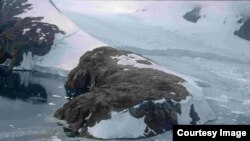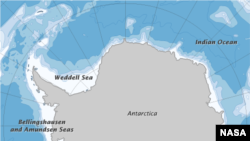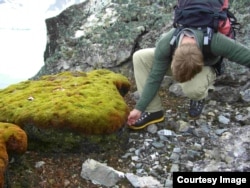The rugged mountain peninsula that juts from the west coast of Antarctica is one of most rapidly warming places on the planet.
With increases as much as 3 degrees Celsius, the once stable sea ice is melting, setting in motion unprecedented ecological changed reported this week in Cell Biology.
Lead author Jessica Royles studies moss in the snow-free zones of the Antarctic Peninsula. She’s a biologist with Cambridge University and the British Antarctic Survey, the organization charged with Britain’s scientific work in Antarctica.
“The moss is really the dominant plant growing in this area, and it accumulates in these moss banks from when the moss starts growing up to the present day," she said, "so it can provide a really good record of changes in the past that have been preserved in the moss.”
The scientists extracted moss cores from this remote and largely inaccessible region and calculated growth rates, examined the conditions for growth and described how the microbial populations have changed.
“What we found is that (the moss) started growing around the year 1860. And it has been growing and accumulating throughout the period up to the present day," Royles said. "But it’s around 1960, the growth rate really rapidly increased, up to a maximum of between five and six millimeters a year.”
Microbes in the moss also multiplied rapidly over the same time frame. Royles attributes the ecological change to warmer temperatures, increased rainfall and stronger winds.
“It’s showing us that really that both the plants and the microbes are really very sensitive to the climate changes that have happened over the last 50 years and that over the time that this moss bank has been growing that those changes are unprecedented.”
Farther north on the Antarctic Peninsula, Royles continues her analysis of moss banks that date back more than 5,000 years.
“So we can now use those moss banks as paleo-archives of past changes in the environment and how they might have occurred, and every little bit of understanding of how those physical climate changes [might have occurred] and the biological responses to that adds to our understanding of our climate system.”
Royles says a scenario in which the polar flora and fauna track the projected warmer temperatures would fundamentally change the ecology and appearance of Antarctica.
With increases as much as 3 degrees Celsius, the once stable sea ice is melting, setting in motion unprecedented ecological changed reported this week in Cell Biology.
Lead author Jessica Royles studies moss in the snow-free zones of the Antarctic Peninsula. She’s a biologist with Cambridge University and the British Antarctic Survey, the organization charged with Britain’s scientific work in Antarctica.
“The moss is really the dominant plant growing in this area, and it accumulates in these moss banks from when the moss starts growing up to the present day," she said, "so it can provide a really good record of changes in the past that have been preserved in the moss.”
The scientists extracted moss cores from this remote and largely inaccessible region and calculated growth rates, examined the conditions for growth and described how the microbial populations have changed.
“What we found is that (the moss) started growing around the year 1860. And it has been growing and accumulating throughout the period up to the present day," Royles said. "But it’s around 1960, the growth rate really rapidly increased, up to a maximum of between five and six millimeters a year.”
Microbes in the moss also multiplied rapidly over the same time frame. Royles attributes the ecological change to warmer temperatures, increased rainfall and stronger winds.
“It’s showing us that really that both the plants and the microbes are really very sensitive to the climate changes that have happened over the last 50 years and that over the time that this moss bank has been growing that those changes are unprecedented.”
Farther north on the Antarctic Peninsula, Royles continues her analysis of moss banks that date back more than 5,000 years.
“So we can now use those moss banks as paleo-archives of past changes in the environment and how they might have occurred, and every little bit of understanding of how those physical climate changes [might have occurred] and the biological responses to that adds to our understanding of our climate system.”
Royles says a scenario in which the polar flora and fauna track the projected warmer temperatures would fundamentally change the ecology and appearance of Antarctica.









